Located 70 miles southwest of Key West, Florida, Dry Tortugas National Park is a remote island destination in the Gulf of Mexico. The park comprises seven low-lying keys and surrounding waters, with Garden Key being the largest and most accessible island. With a total area of approximately 100 square miles, Dry Tortugas National Park is a relatively small park, but it offers history, snorkeling, wildlife viewing, and beaches.

Despite its remote location, Dry Tortugas National Park attracts around 60,000 visitors each year. Visitors come to explore the park’s coral reefs, crystal-clear waters, and diverse wildlife, including sea turtles, sharks, stingrays, and over 300 species of birds. The park’s remote location and limited access also make it an ideal destination for those seeking a peaceful and secluded getaway.
Dry Tortugas National Park is home to Fort Jefferson, a massive 19th-century fort that dominates the landscape of Garden Key. The fort’s imposing structure and rich history are a major draw for visitors, and the park’s surrounding waters and islands allow swimming, snorkeling, and exploring.
- How to Get to Dry Tortugas National Park
- History of Fort Jefferson
- Exploring Fort Jefferson with Kids
- The Keys of Dry Tortugas National Park
- Snorkeling on Garden Key with Kids
- 6 Tips for Snorkeling with Kids
- Camping in Dry Tortugas National Park
- When to Visit Dry Tortugas National Park
- 12 Tips for Visiting Dry Tortugas with Kids
- Tools to Plan Your Family's Trip to Dry Tortugas
- Big Family Accommodations in Key West

How to Get to Dry Tortugas National Park
Getting to Dry Tortugas National Park requires some planning, but the journey is well worth the effort. Located 70 miles southwest of Key West, the park is accessible only by boat or seaplane. Your options for getting to the park include:
Ferry: The Yankee Freedom Dry Tortugas Ferry is the official park concessionaire and offers daily trips to the park. The ferry ride takes about 2.5 hours each way and offers a chance to see dolphins, sea turtles, and other marine life. The ferry leaves from Key West and arrives at the park’s dock on Garden Key. The cost is around $235/adult and $180/child for a day trip, which includes snorkeling gear and breakfast. This option gives you about 4.5 hours to explore the park. Be sure to book your tickets well in advance, as the ferry’s 250-passenger capacity sells out quickly.
Once on board, you’ll find that the ferry ride is a fun and relaxing experience for the whole family. The upper deck offers fresh air and stunning ocean views, while the air-conditioned cabin below provides a comfortable retreat from the sun. You can stretch your legs, explore the ferry, and enjoy the convenience of a snack bar and restrooms on board. After a day of exploring the park, the outdoor fresh water rinse showers are a welcome amenity on the ride back to Key West.
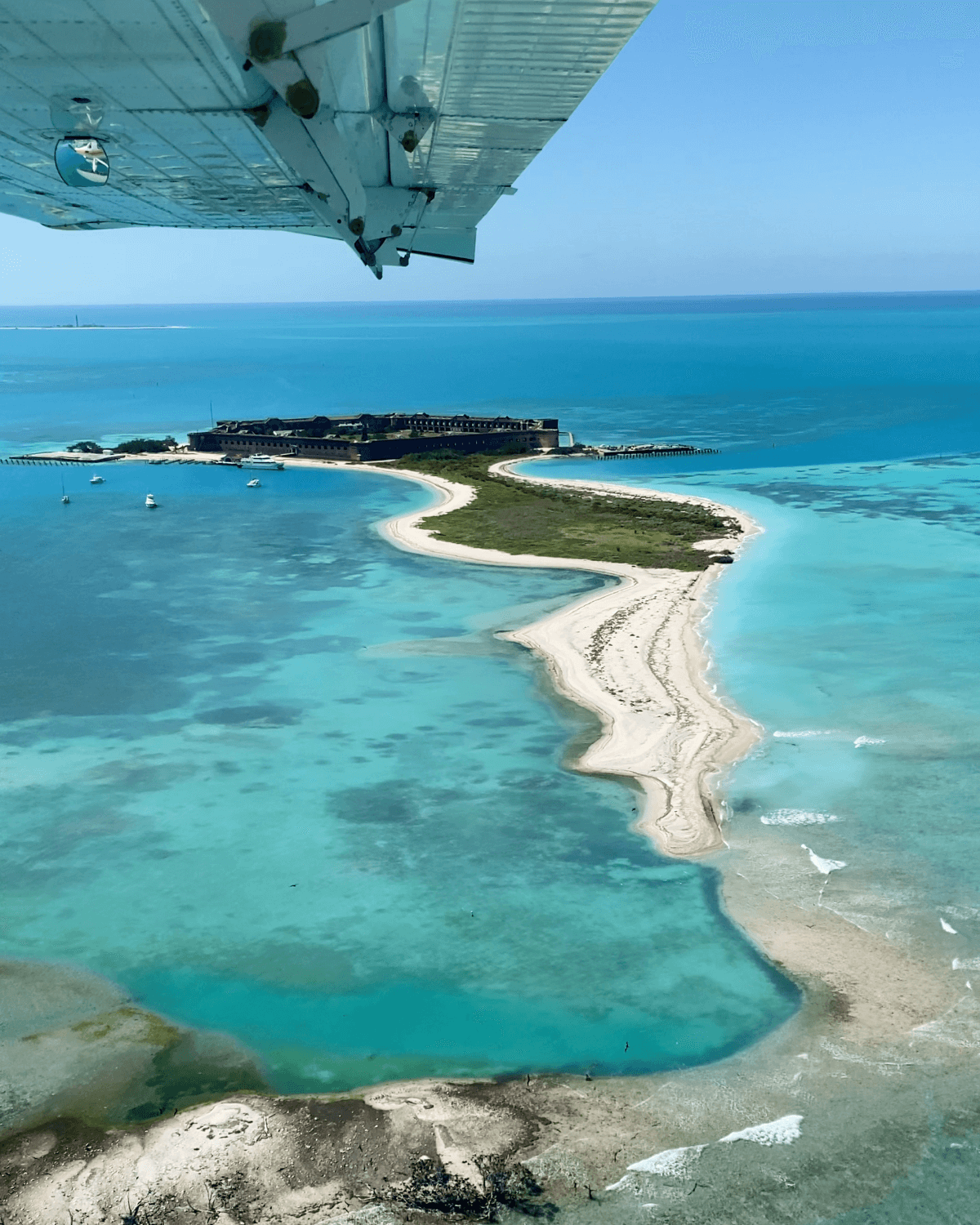
Seaplane: For a more dramatic and faster arrival, consider taking a seaplane to the park. Key West Seaplane Adventures offers half-day and full-day trips to the park, with flight times of around 40 minutes each way. The seaplane lands on the water near the park’s dock, offering stunning views of the island and its surroundings.
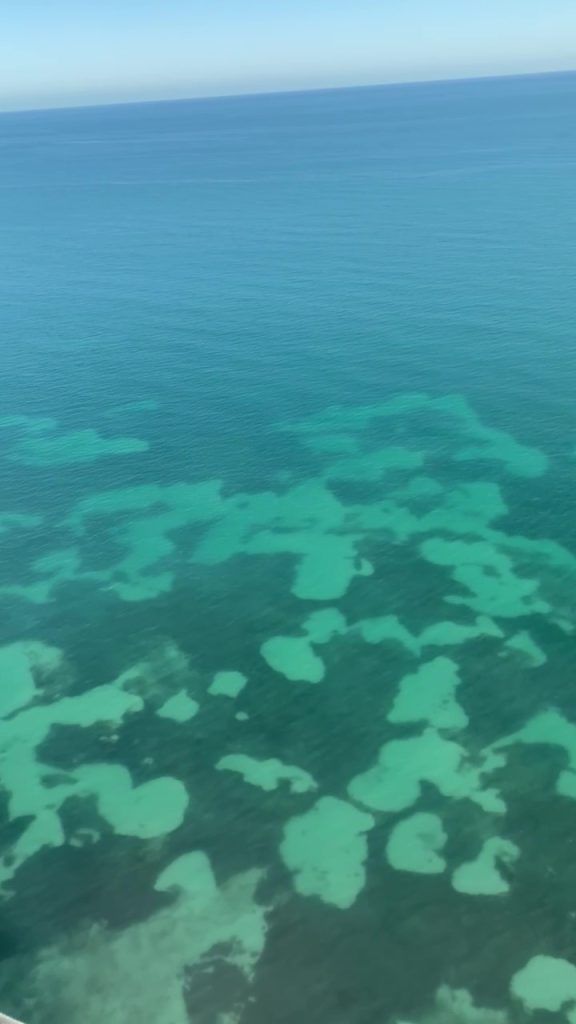
Tour cost is $494/adult and $395/child for a half-day trip, and $900/adult and $700/child for a full-day trip. Children under 2 are free. The half-day option allows a 2.5-hour window to explore while the full-day option provides 6.5 hours of island time. Book your seaplane tickets at least 4 months in advance, as seats are limited (only 10 per flight) and often fill up quickly, especially for big families.
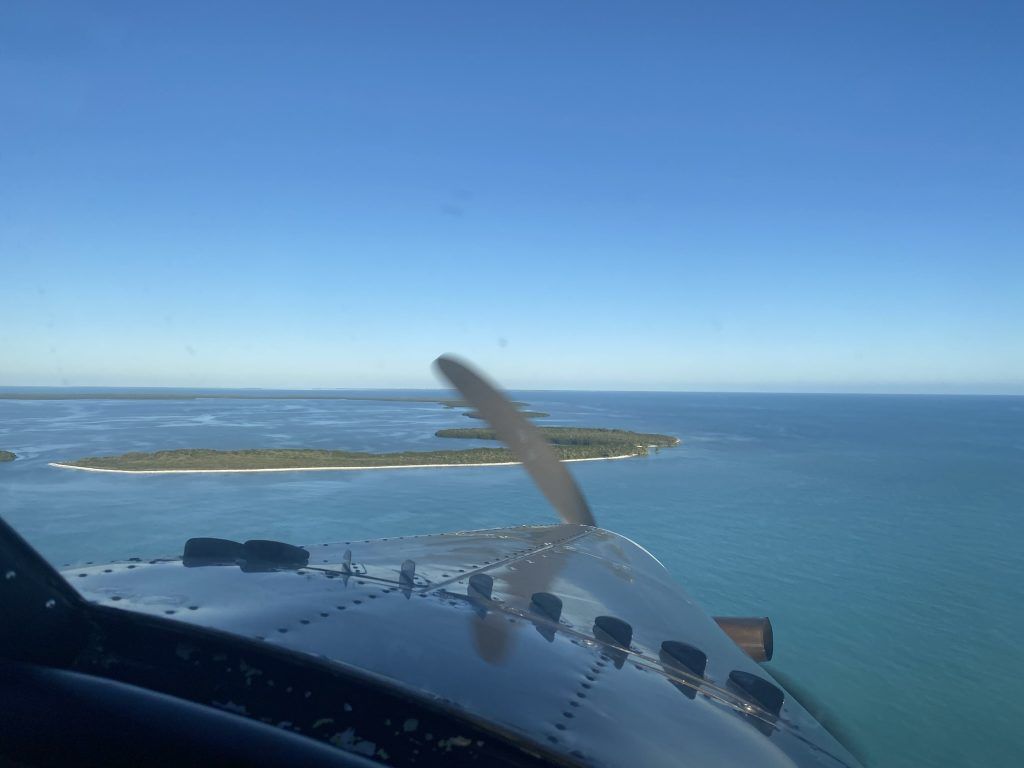
But the seaplane experience is more than just a mode of transportation – it’s a thrilling adventure in itself. The flight from Key West to Dry Tortugas offers breathtaking views of the crystal-clear waters, coral reefs, and island landscapes below. You’ll have a bird’s-eye view of the marine life, including sea turtles, stingrays, and dolphins, making for an unforgettable experience. And, if you’re lucky, you might even get to ride “co-pilot” like I did on the return trip – a truly exhilarating experience that was the highlight of my visit to Dry Tortugas.
Private Tour: For a more personalized and flexible experience, consider booking a private tour of the park. Private charters can accommodate up to six people and offer a customized itinerary to suit your interests. This can be a great option for families who want to explore the park at their own pace. Private tours which are similar in price to the seaplane option, typically include snorkeling gear, lunch, and a knowledgeable captain to guide you through the park’s waters.

History of Fort Jefferson
Construction and Purpose: Fort Jefferson was built by the United States government in the mid-19th century to serve as a strategic military outpost in the Gulf of Mexico. Construction began in 1847 and took over 30 years to complete, with the fort finally being finished in 1875. The fort was designed to protect the shipping lanes and prevent piracy in the area, and its strategic location allowed it to control access to the Gulf of Mexico.
Design and Architecture: Fort Jefferson was designed by the U.S. Army Corps of Engineers and built by a combination of military personnel, civilian contractors, and slave labor. The fort is a massive structure, with walls that rise over 50 feet above the surrounding waters. It is constructed of over 16 million bricks, making it one of the largest brick structures in the Western Hemisphere. The fort’s design was influenced by the French and British fortifications of the time, and its six-sided shape was designed to provide maximum defensive capabilities.
Civil War and Prison Years: During the American Civil War, Fort Jefferson served as a prison for Confederate deserters and Union soldiers who had committed crimes. The most famous prisoner to be held at the fort was Dr. Samuel Mudd, who was convicted of complicity in the assassination of President Abraham Lincoln. Mudd was sentenced to life imprisonment at the fort, but he was later pardoned by President Andrew Johnson in 1869. The fort continued to serve as a prison until the late 1800s.
Later Years and Decline: After the Civil War, Fort Jefferson’s importance as a military outpost began to decline. The fort was used as a quarantine station and a refuge for ships in distress. However, the fort’s remote location and lack of maintenance led to its gradual decline, and by the early 20th century, it had been largely abandoned. In 1908, President Theodore Roosevelt established the Tortugas Keys Reservation, which included the fort and surrounding islands, as a wildlife refuge.
National Park Status In 1935, Fort Jefferson was declared a national monument, and in 1992, the area was redesignated as Dry Tortugas National Park. Today, the fort is one of the park’s main attractions, and it is open to visitors who come to explore its historic walls and learn about its rich history. Despite its decline and neglect over the years, Fort Jefferson remains an impressive and fascinating piece of American history, and it continues to attract visitors from around the world.

Exploring Fort Jefferson with Kids
Fort Jefferson is a massive and impressive structure, with walls that rise 45 feet above the surrounding waters. While there are many informative placards in the park, consider reviewing this self-guided tour guide before your trip. As you explore the fort, you’ll discover fascinating features and architectural details. Here’s a guide to help you navigate the fort’s various components:
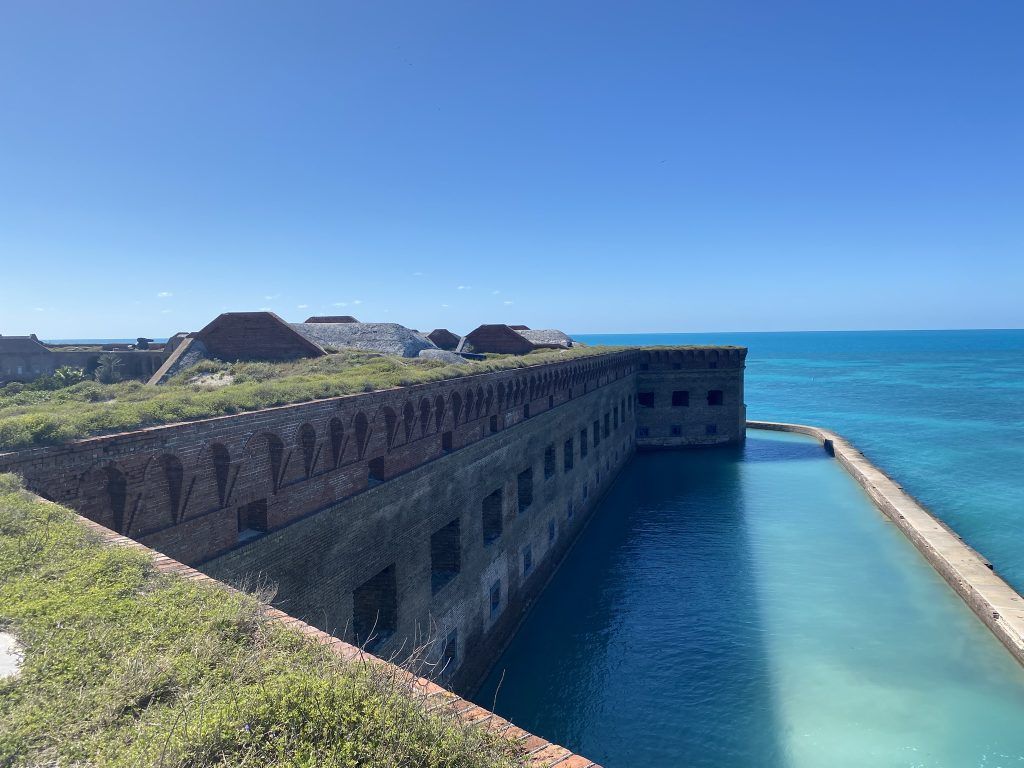
The Walls: The 45-foot-tall battlements offer breathtaking views of the surrounding waters and provide a glimpse into the fort’s strategic importance. As you walk along the walls, you’ll notice the intricate stonework and the sheer scale of the fort’s construction.
Fun fact: There are more than 2000 brick arches in the fort.
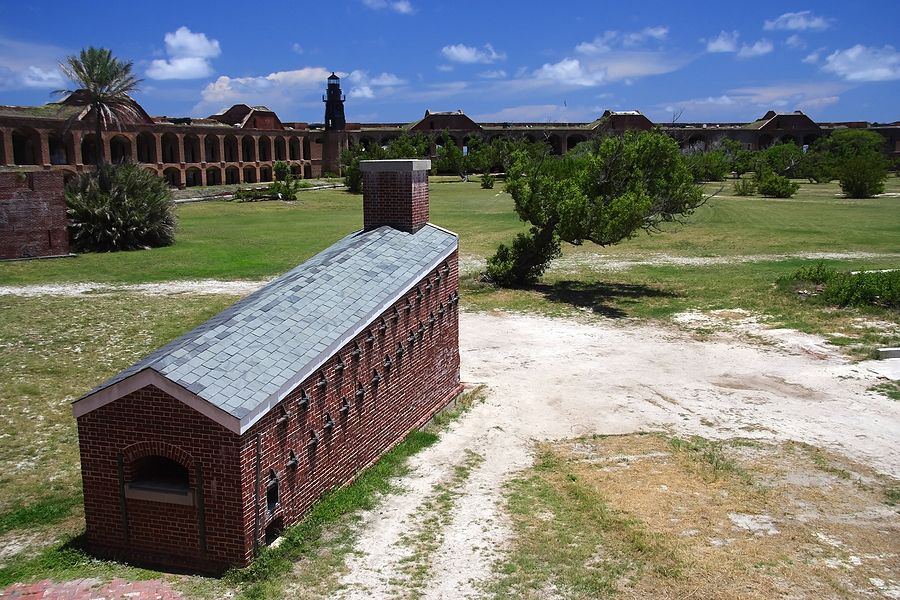
The Courtyard: The courtyard offers a peaceful respite from the sun and the sea. The courtyard is surrounded by the fort’s walls and bastions, and it’s a great place to take a break and admire the fort’s architecture.
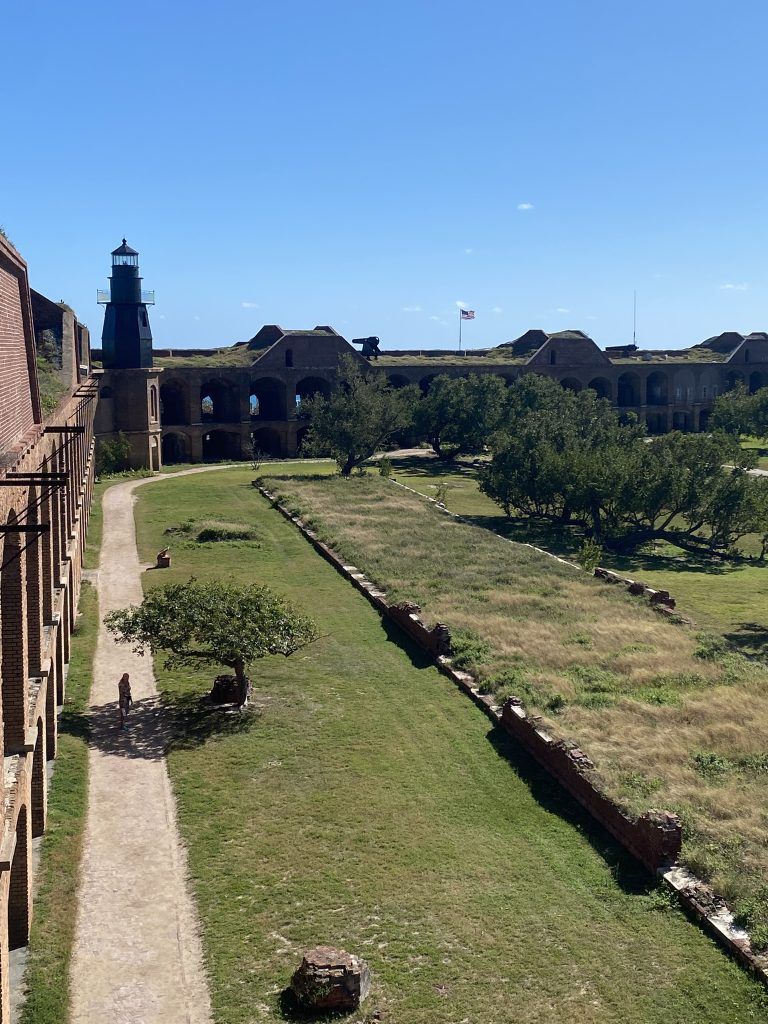
The Lighthouse: The Tortugas Harbor Light, officially known as The Lighthouse, is situated on Bastion 6 of Fort Jefferson. Although it’s not as tall as some other lighthouses, the Tortugas Harbor Light is an important aid to navigation and offers stunning views of the surrounding waters.
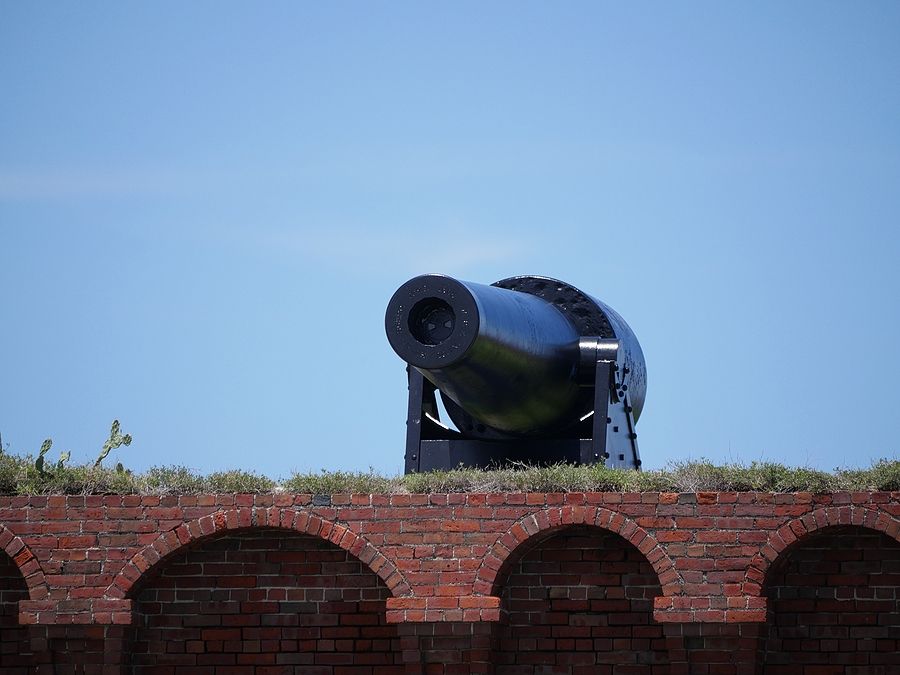
Bastions: The fort’s hexagonal plan is punctuated by six corner bastions, which are large projections designed to allow defensive fire along the faces of the walls they joined. The bastions are an essential part of the fort’s design, providing a secure location for guns and other defensive equipment.
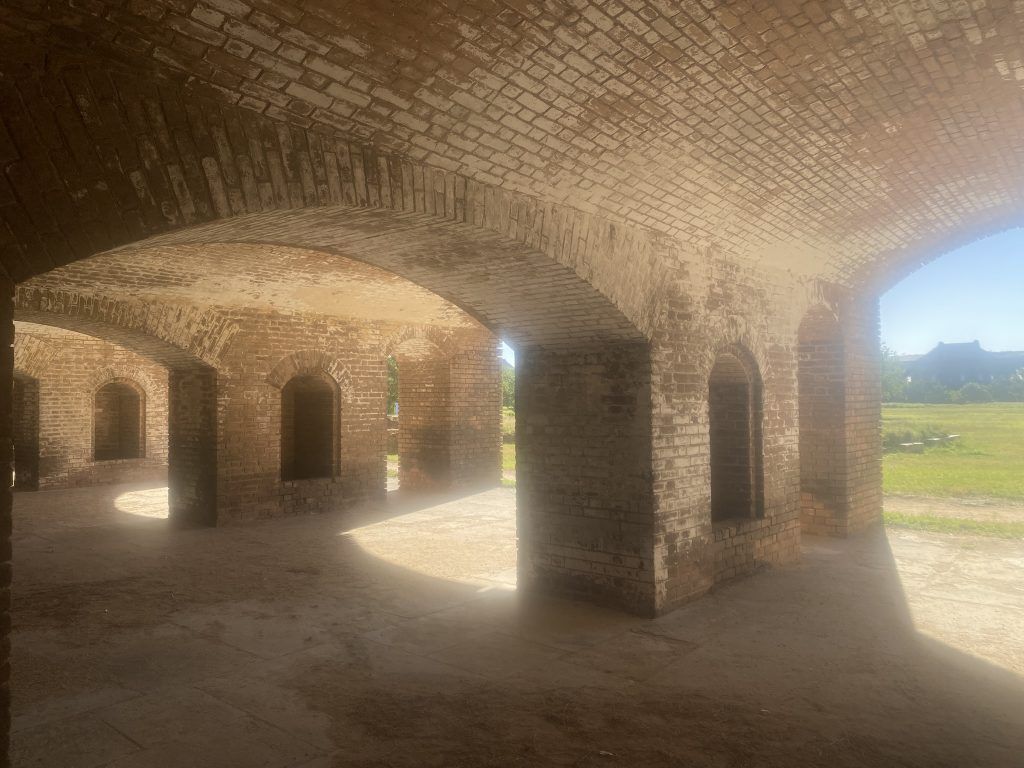
Casemates: Most of Fort Jefferson consists of gunrooms known as casemates, which are a honeycomb of masonry arches that served as the backbone of the fort. The casemates are an impressive feat of engineering, with intricate stonework and precise construction.

Embrasures: The heavy guns were mounted inside the walls in a string of open casemates, or gunrooms, facing outward toward the sea through large openings called embrasures. The embrasures are an important feature of the fort’s design, allowing the guns to fire out to sea while protecting the gun crews from incoming fire.
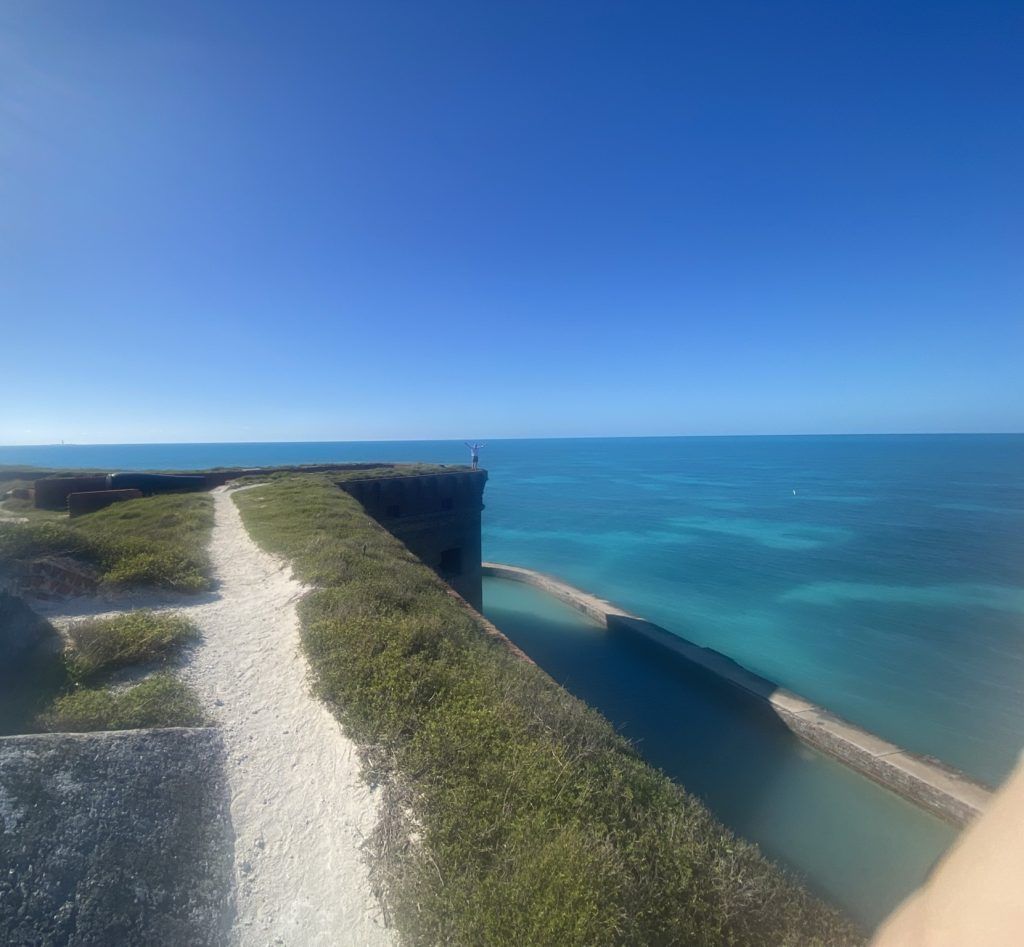
Safety note: As you explore Fort Jefferson, please exercise caution when walking along the top 3rd floor, also known as the ramparts. There are no railings or barriers to protect you from the steep drop-offs to the moat below.
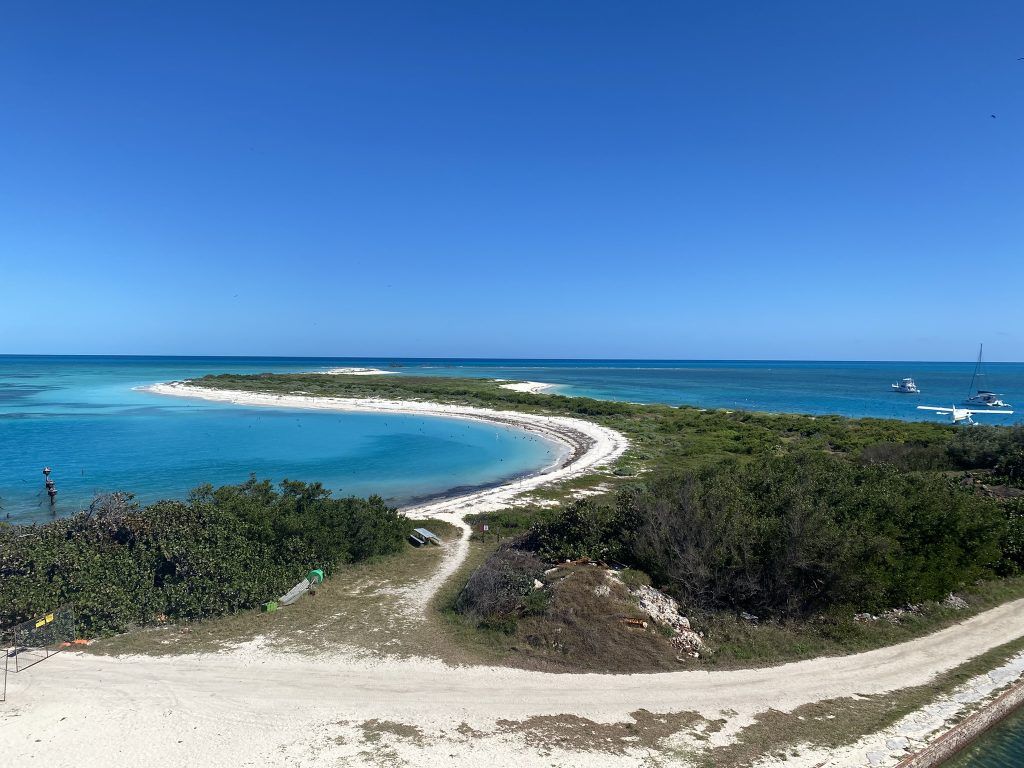
The Keys of Dry Tortugas National Park
Dry Tortugas National Park is composed of seven small islands, known as keys, which are scattered across the Gulf of Mexico. Each key has unique characteristics and attractions. Here’s a brief overview of three of the most popular keys:
Garden Key: The largest and most accessible of the keys, and it’s home to Fort Jefferson, the park’s iconic 19th-century fort. The key is surrounded by crystal-clear waters, making it a perfect spot for snorkeling and swimming. The waters around Garden Key are home to marine life, including sea turtles, stingrays, and colorful fish of all kinds. Visitors can also explore the key’s beaches.
Bush Key: A smaller key located just north of Garden Key, and it’s a haven for birdwatchers and nature enthusiasts. The key is home to a wide variety of bird species, including sooty terns, brown noddies, and frigatebirds. However, due to the sensitive nature of the bird habitats, Bush Key is closed to visitors from March to September to protect the nesting and breeding activities of these birds. During the winter months, visitors can explore the key’s beaches and snorkel in the surrounding waters, which are home to sea turtles, stingrays, and other marine life. A one-mile loop trail also allows visitors to walk around the key on the shoreline.
Loggerhead Key: Only accessible by private boat, making it a more secluded and exclusive destination for those who venture to this remote corner of the park. Loggerhead is the westernmost of the keys, and it’s a popular day-use spot for snorkeling and swimming. The waters around Loggerhead Key are home to stunning marine life, including loggerhead sea turtles, stingrays, and colorful fish of all kinds. The key’s beaches are also perfect for sunbathing, beachcombing, and relaxing.
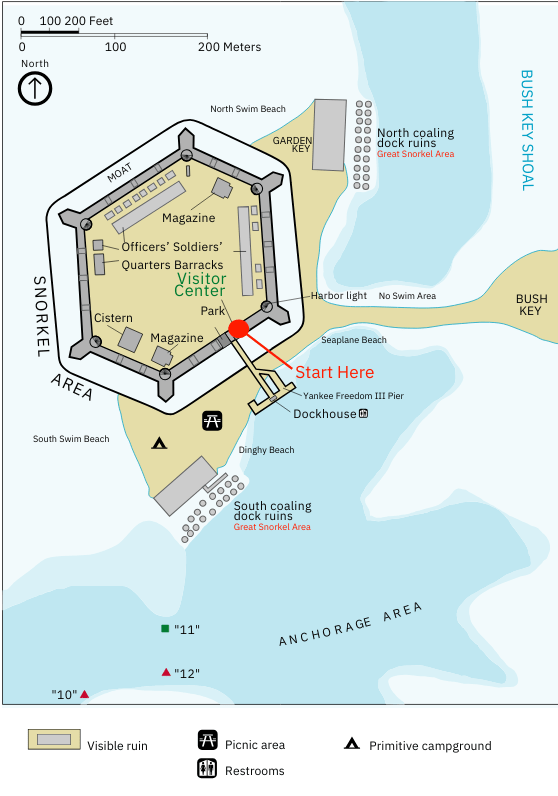
Snorkeling on Garden Key with Kids
The crystal-clear waters surrounding Garden Key, where Fort Jefferson is situated, offer an unforgettable snorkeling experience. With vibrant coral reefs, tropical fish, and historic artifacts to explore, snorkelers of all levels can enjoy the breathtaking beauty of this marine sanctuary. Four must-visit spots to snorkel at Dry Tortugas include:
- The Moat: Snorkeling in the moat surrounding Fort Jefferson offers a unique perspective on the historic structure. The waters are shallow, typically ranging from 5-15 feet, making it perfect for beginners. The moat is home to tropical fish, sea grass, and coral heads.
- South Coaling Dock Ruins: Located near the western edge of the island, the South Coaling Dock Ruins offer a snorkeling experience for intermediate to advanced snorkelers. The metal pilings of the old coaling docks are now home to marine life, including fish, coral, and other invertebrates.
- North Coaling Dock Ruins: Similar to the South Coaling Dock Ruins, the North Coaling Dock Ruins provide a glimpse into the island’s industrial past. The remains of the coaling dock have become a thriving ecosystem, with coral, fish, and other marine life making their home among the metal pilings.
- Dr. Mudd’s Reef (75 yards from the western edge of the moat): This spot, located approximately 75 yards from the western edge of the moat, is a great place for seasoned snorkelers. The area features large coral heads, tropical fish, sea grass, and other marine life.
Remember to always snorkel with a buddy and to follow all safety guidelines and park rules. It’s also a good idea to check with park rangers or visitor centers for up-to-date information on snorkeling conditions and any specific regulations or guidelines.
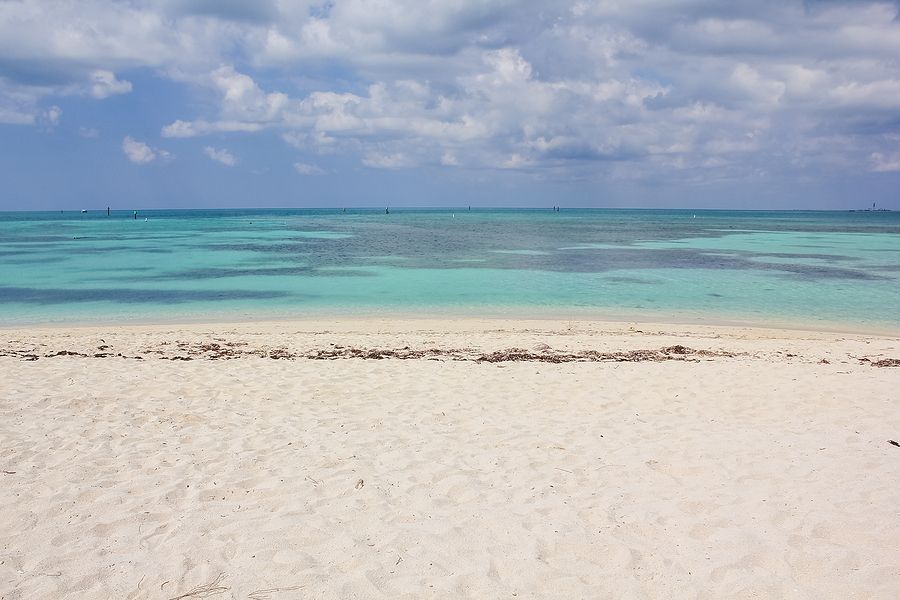
6 Tips for Snorkeling with Kids
- Make sure kids are comfortable in the water and have basic swimming skills before attempting to snorkel.
- Use kid-friendly snorkeling gear, such as masks and snorkels designed for children.
- Start in shallow water and gradually move to deeper areas as kids become more comfortable. The beach on Garden Key is another great spot for snorkeling, particularly for beginners. The water is shallow and clear, making it easy to spot marine life.
- Encourage kids to breathe slowly and calmly while snorkeling to avoid fogging up their masks.
- Remind kids to respect the marine environment and not touch or disturb the coral or other marine life.
- Know when to call it quits: Snorkeling can be a wonderful experience for kids, but it’s not always easy. If your child is getting frustrated, anxious, or uncomfortable, it’s okay to call it quits and try again another time.
Camping in Dry Tortugas National Park
The park offers 10 primitive campsites on Garden Key, which are available on a first-come, first-served basis. Additionally, there is one group campsite that can accommodate up to 20 people, which can be reserved in advance. Camping in the park allows you to experience the unique sounds and sights of the island at night, including the stunning sunsets and star-filled skies. However, keep in mind that camping in the park is primitive, and you will need to bring all your own gear, including food, water, and supplies.

When to Visit Dry Tortugas National Park
The best time to visit Dry Tortugas National Park is from December to April when the weather is cooler and drier, and the crowds are smaller. However, if you’re interested in birdwatching or prefer warmer weather, the spring and fall months can also be a good time to visit. We visited the park in March and found the weather to be pleasant, with mild temperatures and plenty of sunshine, making it an ideal time to explore the island and enjoy the outdoors.

12 Tips for Visiting Dry Tortugas with Kids
- Protect your skin: The sun can be intense at Dry Tortugas, so be sure to pack coral-safe sun block, hats, and sunglasses for your kids. Set a timer on your phone to reapply.
- Pack your own water and snacks: There are no concessions or restaurants on the island, so it’s essential to bring your own water and snacks to keep your kids hydrated and energized.
- Wear water shoes: Water shoes are a great option for the beach, as they provide protection from sharp rocks and shells.
- Plan for check-in and boarding time: Whether you’re taking the ferry or seaplane, be sure to arrive early to allow time for check-in, boarding, and security checks.
- Pack dry clothes: After swimming and snorkeling, your kids will need to change into dry clothes. This is especially important if you’re taking the seaplane, as wet clothes are not allowed on board.
- Take advantage of changing rooms: There are changing rooms available on the island, so be sure to use them to change into dry clothes or to rinse off after swimming.
- Be prepared for limited shade: There isn’t a lot of shade on the island, so be sure to pack umbrellas or canopies to provide some relief from the sun.
- Bring Dramamine for seasickness: If your kids are prone to seasickness, be sure to pack some Dramamine to help alleviate symptoms.
- Remember your ID: All adults must provide photo ID for both ferry and seaplane tours when checking in.
- Bring your own snorkel gear: While snorkel gear is provided by the ferry and seaplane operators, it’s often a good idea to bring your own gear to ensure a proper fit and to avoid any issues with leaks. Consider investing in full-face masks, which can provide a more comfortable and secure snorkeling experience for kids. This will help them to focus on enjoying the underwater world, rather than struggling with their gear.
- Explore the Fort first, then enjoy the beaches and snorkeling. Allow at least 1-2 hours to explore the fort, depending on your family’s interest and pace. Then cool off at the beaches.
- Prioritize your visit: Focus on what interests you most: If you’ve toured other forts before and are mainly interested in snorkeling, it’s perfectly fine to skip the fort tour and head straight to the beach. Conversely, if you’re fascinated by history and not interested in snorkeling, you can focus on exploring the fort and enjoying the beach without feeling obligated to snorkel.
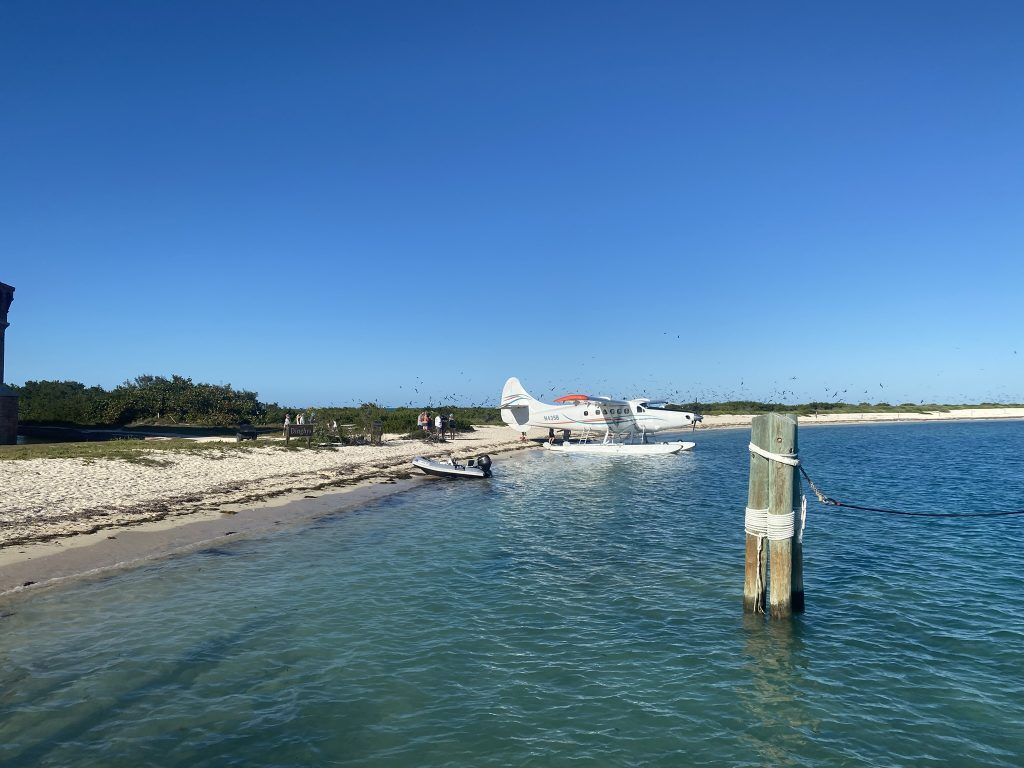
Tools to Plan Your Family’s Trip to Dry Tortugas
Educational Resources
For a fun and educational experience, consider buying books to read before your trip:
- For younger kids (ages 4-8)
- For older kids (ages 9-12)
- For teens
Big Family Accommodations in Key West
Find hotels in Key West that can accommodate your big family. For large families and longer vacations, consider a vacation rental.
Nearby Airports and Car Rental Options
On our trip, we flew to Fort Lauderdale-Hollywood using Southwest Airlines Travel Points, which made our trip even more affordable. We visited the park as part of a 3 Florida National Park + Keys Road Trip. If you’re looking to maximize your travel budget, consider signing up for a Southwest Rapid Rewards® Credit Card to earn points for future adventures.
Miami International Airport: If you’re looking for a wider range of flight options and more competitive prices, consider flying into Miami International Airport, which is about 166 miles northeast of Key West. From there, you can rent a car and drive to Key West.
Key West Airport: If you prefer a more direct route and don’t mind paying a bit more, consider flying into Key West Airport, which is located just a few miles from downtown Key West. This airport is ideal for those who want to minimize their travel time and get to their accommodations quickly.
Both airport options (MIA and EYW ) feature top car rental companies. Due to the popularity of the area, we recommend checking in online to avoid long lines.
